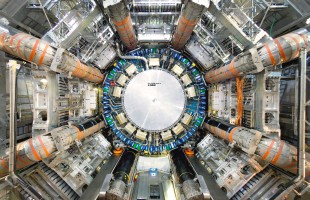In theory, electrons, muons and tau-leptons are identical, apart from their mass. But measuring is knowing, and the ATLAS experiment is the first to use the LHC accelerator to do so.
Today the experiment publishes an analysis of the so-called lepton universality that was measured by collisions at the LHC accelerator at CERN in Geneva. This looked at any differences in the coupling of particles to the W particle, carrier of the weak interaction.

Leptons are elementary particles in the standard model. The electron is the best known. But in nature there also appears to be a 200 times heavier version, the muon. And an even much heavier tau particle.
As far as theorists know, mass is the only difference between these particles. Question with that is why three generations of a similar particle actually exist in the particle world. “Who ordered this?”, physicist Rabi once wondered, when muons turned up in cosmic rays.
New measurements of the comparability of muons and tau particles had been eagerly awaited for years. In 2013, measurements from LEP, the predecessor of the LHC at CERN, suggested that there could be an additional difference between muons and tau particles. The difference between electrons and muons already seemed minimal there.
In recent years, lepton universality has been a hot topic in particle physics. In the LHCb experiment, also at CERN, a possible deviation between electrons and muons was seen this spring. It was not yet statistically hard. But anomalies could indicate a new force in particle physics.
The uncertainty of the earlier anomaly in LEP was 2.7 sigma, intriguing but not yet a serious difference. In the new ATLAS measurements, the uncertainty has been halved, but the possible difference between tau and muon has also disappeared.
Still, this is a remarkable result, says ATLAS group leader Wouter Verkerke of Nikhef. That is not directly involved in these analyses.
The difference is that LEP could make W and Z particles with colliding point particles without much background noise back then. “The LHC lets protons collide, not point particles so which gives much more background. We now see that you can still distill this analysis from that,” Verkerke says.
ATLAS experiment tests flavor change in leptons
On July 1, Nature Physics published an article from the ATLAS collaboration on what is called charged lepton flavour violation, violations of the rule that in particle collisions the number of charged elementary particles of a given type does not change. The standard model has three such types (flavors): the electron, the muon and the tau particle. In principle, these three differ only in mass, unless unknown forces are involved.
Flavor changes in the particle world do exist: the uncharged electron, muon or tau neutrinos demonstrably do switch identities among themselves. In theory, an electron never becomes a muon or tau particle, or vice versa, without neutrinos and anti-neutrinos coming into play to keep the accounts correct. Thus, a tau particle can become a muon if a tau neutrino and an anti-muon neutrino are released at the same time.
But really it doesn’t seem forbidden either and there are many theories that predict an anomaly. Tests may be able to indicate which of them is correct.
In proton collisions at the LHC accelerator, the ATLAS detector looked at the decay of released Z particles for any changes along the way of electrons in tau particles or muons in tau particles. The probability of this is extremely small with high precision, is the conclusion of ATLAS, based on measurements of Z decays so far.
This was also the conclusion of experiments in the 1990s at the LEP accelerator, the predecessor of the current LHC accelerator at CERN. Still, says ATLAS group leader Wouter Verkerke of Nikhef, this is an important result. “At LEP, it was all about collisions of point particles that provide neat Z bosons and little disruptive background. At LHC you have colliding protons, compound particles that give much more background. But also a lot more Z particles which allows us to do this analysis well, it now appears.”
The methodologies for the new analyses in ATLAS rely in part on the work of the late Nikhef researcher Olga Igonkina (1973-2019) and her team, who continued the work after her death. In the coming years, with more measurements at the LHC, the precision of the test after charged lepton flavour violation will grow much further, it is expected.

